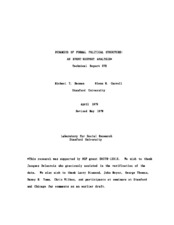| dc.creator | Hannan, Michael T | |
| dc.creator | Carroll, Glenn R | |
| dc.date.accessioned | 2015-08-16T01:11:48Z | |
| dc.date.available | 2015-08-16T01:11:48Z | |
| dc.date.issued | 2015-08-15 | |
| dc.identifier.uri | https://hdl.handle.net/1969.1/154808 | |
| dc.description.abstract | The authors apply event history analysis to records on 90 countries from 1950-1975 to test hypotheses consistent with world systems and modernization hypotheses. The hypotheses predict factors associated with political change from/to one-party and multi-party governments. Modernization hypotheses predict that changes making a society more modern (that is, more like European societies) increase the chances for multi-party democratic governments. World systems hypotheses predict that governments are more affected by a country’s place in the world economic system than by internal changes. Results here show small effects of modernizing on government form, and event history methods show a complex relationship between GNP per capita and form of government. | en |
| dc.language.iso | en_US | |
| dc.relation.ispartofseries | Technical Report Stanford Sociology;#72 | |
| dc.rights | Attribution 3.0 United States | en |
| dc.rights.uri | http://creativecommons.org/licenses/by/3.0/us/ | |
| dc.subject | event history models | en |
| dc.subject | modernization hypotheses | en |
| dc.title | Dynamics of Formal Political Structure: An Event-History Analysis | en |
| dc.type | Technical Report | en |
| local.department | Sociology | en |



